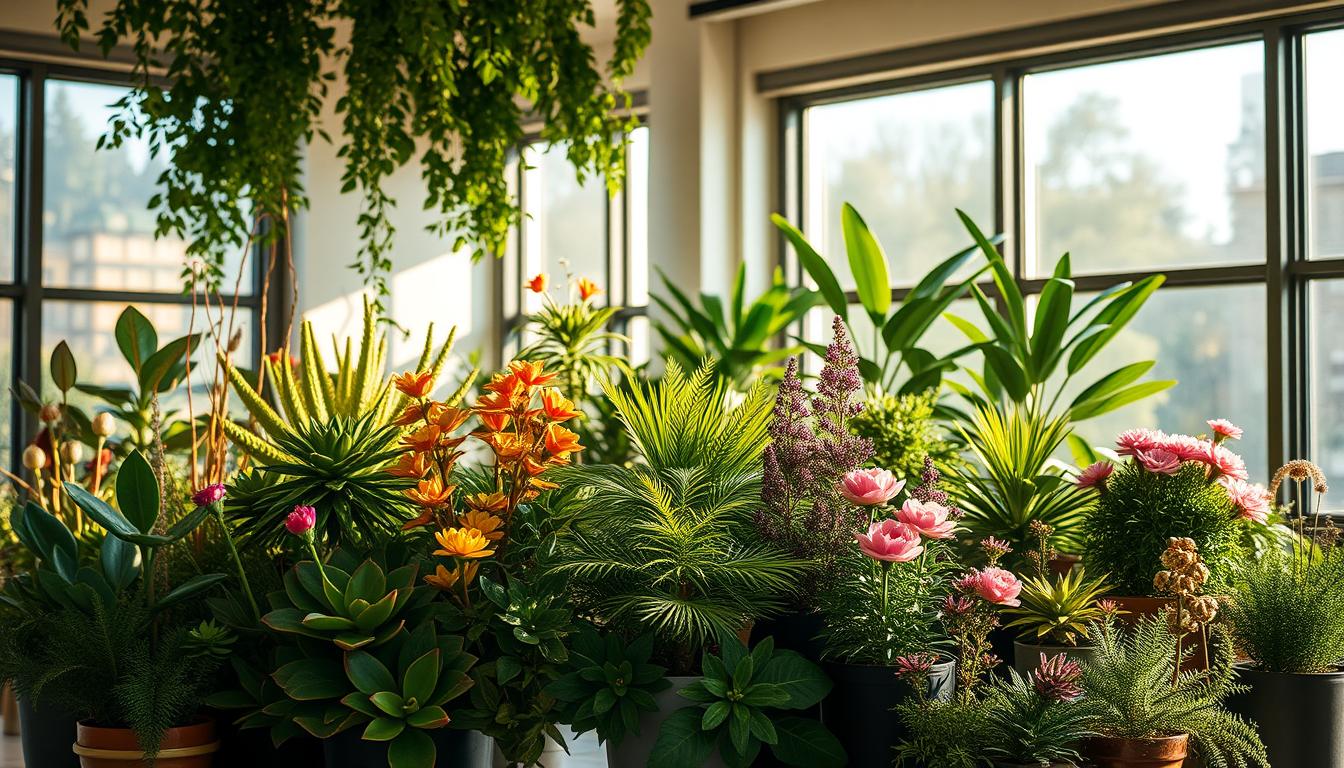
At first, I was unsure about adding artificial plants to my home. Old, cheap imitations came to mind, often seen in dull offices. But, today’s artificial plants are a game-changer. They are made with great care, bringing life and color to my home.
These plants not only make my home look better but also feel calmer. Unlike real plants, they don’t need constant care. This makes them perfect for adding beauty and ease to my home.
Key Takeaways
- Artificial plants that look real have evolved significantly in design and quality.
- Lifelike artificial greenery can enhance your home’s aesthetics without high maintenance.
- Realistic faux plants offer practical benefits for those with busy lifestyles.
- Choosing high-quality materials is key to achieving a natural look.
- Consider integrating artificial plants in various areas to enrich your living spaces.
Why Choose Artificial Plants for Your Home?
Artificial plants bring many benefits to any home. They look real and can fit well in different spaces. This makes them a great choice for those who want beauty without the upkeep of real plants.
The Benefits of Artificial Plants
Artificial plants are easy to care for. They don’t need watering, sunlight, or constant attention like real plants do. They last a long time and don’t fade or deteriorate like natural plants do.
They’re also safe for homes with pets or young kids. If they get knocked over, they won’t harm anyone.
A Practical Choice for Busy Lifestyles
Artificial plants are perfect for busy people like me. They’re easy to keep up with, even in busy areas of the home. They add a calming touch to rooms like the living room or office.
This makes our homes feel welcoming and peaceful. It’s a smart way to add style without spending a lot of time on it.
Realism in Design: What to Look For
When picking out fake plants, look for details that make them seem real. Texture, color, and even small flaws are key. These details help the plants look natural and inviting.
Key Features of Lifelike Artificial Plants
Realistic fake plants have certain traits. These include:
- Texture: The surface should feel and look like real leaves.
- Color variations: Small changes in color can make a big difference.
- Realistic stems and leaves: Look for plants with well-made parts that look like nature.
- Imperfect details: A little flaw can make the plant look more real.
Understanding Materials Used
The materials used in fake plants affect their look and how long they last. Here are some common ones:
| Material | Characteristics | Benefits |
|---|---|---|
| Polyester | Soft, flexible, and durable | Holds color well and resists fading |
| Silk | Rich textures and vibrant colors | Luxurious appearance, often indistinguishable from real plants |
| Plastic | Lightweight and easy to care for | Typically more affordable and versatile in design |
In my search for the best fake plants, I found that mixing materials makes them stunning. They look great and need little care. The right choice can make any space feel more alive and welcoming.
Popular Types of Realistic Artificial Plants
Lifelike artificial greenery is now a big hit in decor. Realistic faux plants come in many styles to match different tastes. They add beauty and meet the needs of today’s homes.
Faux Foliage for Indoor Spaces
Faux foliage brings life to indoor spaces. Ferns and pothos are favorites for their natural look. They add color and vibrancy without the need for care.
These plants turn any corner or shelf into a lively spot. No need to worry about watering or pruning.
Stunning Faux Flowers for Accents
Faux flowers can make any room pop. Peonies and orchids are stunning as accents, adding color and elegance. They’re perfect for seasonal decor or brightening up any space.
The best part? They never wilt, keeping their beauty for a long time.
Low-Maintenance Succulents and Cacti
Succulents and cacti are great for a modern touch. They look like real plants but are easy to care for. Their small size fits well in small spaces or busy homes.
These plants are stylish and easy to care for, making them a great choice.
Where to Use Lifelike Artificial Plants in Your Home
Using realistic artificial plants can make your home look better. They are easy to care for and can be placed in many spots. Here are some ideas for where to put them.
Living Room Arrangements
In the living room, artificial plants can be a big highlight. Choose stylish containers like ceramic pots or woven baskets. Big plants like bamboo and palm can fill corners, while small ones look good on shelves. The Aveyas 6ft Artificial Fiddle Leaf Fig Tree is a great option if you’re searching for a statement piece with a natural flare. It’s lush, incredibly tall, and has lifelike silk leaves that add vitality to any living area. 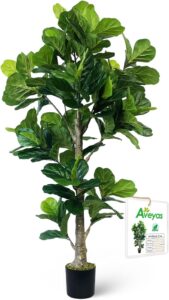
I like having a peace lily on the coffee table for elegance. Mixing real and fake plants adds texture and variety.
Enhancing Office Spaces
In my office, fake plants make me more productive. They add color and calmness. I use small plants like ZZ or rubber on my desk or windowsill.
These plants break up the look of office supplies and keep things professional. For more ideas, check out this resource on decorating workspaces with plants.
Outdoor Areas and Patios
Outdoor spaces can also benefit from fake plants. Artificial plants in outdoor planters keep your space green all year. Choose durable materials like fiberglass or concrete for outdoor use.
Setting up small gardens with vines or boxwood can make patios more welcoming. These plants fit well with many designs, showing their versatility outdoors.
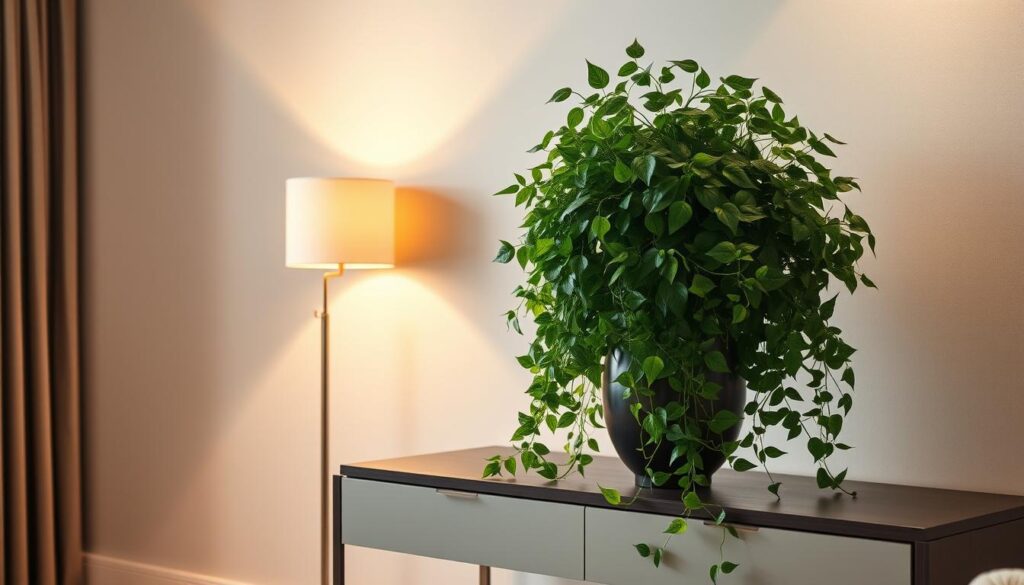
How to Style Artificial Plants for Maximum Impact
Using lifelike artificial greenery can make your home feel welcoming and beautiful. I’ve learned how to create stunning displays with high-quality fake plants. By mixing different heights and textures, I add interest to my arrangements.
Adding natural-looking fake plants with real ones can take your decor to the next level. It creates a unique contrast that enhances the overall look.
Tips for Creating Stunning Displays
To make your artificial plants stand out, follow these tips:
- Vary Heights: Place plants at different levels to add depth. Use stands for some and floor placement for others.
- Mix Textures: Combine shiny and matte leaves for a more realistic look. It adds intrigue to your displays.
- Group Plants: Grouping lifelike artificial greenery creates a dynamic look. It draws the eye and highlights focal points.
- Incorporate Decorative Containers: Choose pots or baskets that match your decor. The right container can make your display even more appealing.
Mixing and Matching with Real Plants
Mixing natural-looking fake plants with real ones makes for captivating displays. The contrast between them adds depth.
When combining, pick plants that need similar care and look good together. This mix adds variety and keeps your space looking cohesive. I find that using artificial plants in low-light areas works well. It ensures each plant gets the right amount of light.
Maintenance Tips for Artificial Plants
Keeping your fake plants in top shape is key to their longevity and look. Knowing how to clean and care for them can make them look new and vibrant. It’s important to pay attention and use the right methods to avoid damage.
Cleaning and Caring for Faux Foliage
It’s vital to clean your artificial plants well to keep them looking real. Use a soft, dry cloth to wipe off dust and dirt from the leaves and petals. For tougher stains, a mild soap and water mix works well. But, use a damp cloth, not soaking wet, to avoid damage.
Keep your plants out of direct sunlight to prevent fading and damage. Check them often for wear and tear. Storing them in a controlled environment helps keep them looking good.
Avoiding Common Mistakes
While caring for your plants might seem easy, some mistakes can harm them. Don’t use harsh chemicals or heavy cleaning tools that can scratch or tear them. Too much moisture can cause mold, so keep them dry.
Rotating your plants helps them get even light, preventing fading. By following these tips, your fake plants will stay beautiful for a long time.
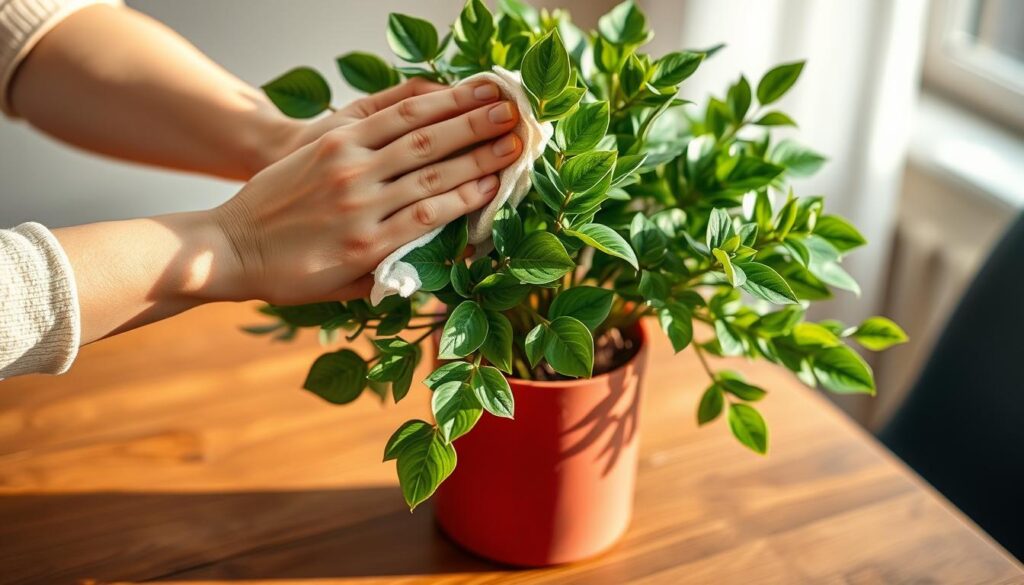
The Cost-Effectiveness of Lifelike Plants
Thinking about buying lifelike artificial plants? The cost is a big factor. These plants are a smart choice because they save money in the long run. They don’t need water, soil, or constant care, which saves a lot of money.
Comparing to Real Plants in the Long Run
Real plants cost money for soil, fertilizer, and sometimes need to be replaced. But, faux plants keep looking great without adding to your expenses. They last a long time, so you don’t spend much on them. Here’s a comparison of costs over five years:
| Expense Type | Real Plants | Cost-effective Artificial Plants |
|---|---|---|
| Initial Purchase Cost | $100 | $150 |
| Maintenance (Yearly) | $60 | $0 |
| Replacement (Every 2 Years) | $100 | $0 |
| Total Cost Over 5 Years | $460 | $150 |
Investment vs. Aesthetic Value
Faux plants add beauty to your home without the hassle of real plants. They don’t wilt or get pests, making them a great choice. They balance beauty and practicality, helping you make smart decorating choices.
Choosing the Right Size and Proportion
Choosing the right plant sizes is key to a harmonious space. High-quality fake plants can make your room look great. But, they must match the furniture and decor well. Learning how to pick the right size for your plants is essential for a unified look.
Understanding Scale in Home Decor
Scale means how big an object is compared to its surroundings. Think about the ceiling height, furniture size, and room layout when picking plants. For example:
- Tall plants are perfect for rooms with high ceilings, making them look taller.
- Medium-sized plants are great for filling spaces without being too much.
- Small plants create cozy spots and can be placed on shelves or tables.
Finding the Perfect Fit for Each Room
Each room in your home needs different plant sizes. Mixing various sizes of fake plants can make a space look more sophisticated. Here are some tips for finding the right fit:
- Figure out where big plants will stand out and where small ones might get lost.
- Use stands or pedestals to make plants look taller and more interesting.
- Group small plants together for a cozy, layered look.
By picking the right plant sizes, you can create beautiful arrangements. Spending time on this can really enhance your home’s decor.
| Room Type | Recommended Plant Size | Suitable Plant Types |
|---|---|---|
| Living Room | Tall | Palm trees, Fiddle Leaf Figs |
| Office | Medium | Snake Plants, Pothos |
| Bedroom | Small | Succulents, Miniature Ferns |
| Outdoor Patio | Varied | Large tropical plants, Bougainvillea |
Sustainability of Artificial Plants
Exploring home decor, I find sustainability with artificial plants key. New tech has brought sustainable artificial plants to the market. These plants aim to reduce environmental harm while looking great. They’re made from materials that are better for the planet, making them a good choice for those who care about the environment.
Eco-Friendly Materials and Practices
Today, makers focus on materials that are both realistic and green. They use plastics like Polyethylene Terephthalate (PET) and High-Density Polyethylene (HDPE). These choices help cut down on landfill waste. There are also biodegradable options that break down naturally, adding to the eco-friendly appeal.
Knowing what goes into artificial plants helps me make better choices. It lets me pick decor that’s good for the planet.
Longevity and Environmental Considerations
Sustainable artificial plants last a long time, which is a big plus. They don’t need to be replaced as often as real plants. This means less waste and a smaller environmental impact over time.
For those who care about the planet, these plants are a great option. They let me decorate without worrying about constant replacements. For more on sustainability in this field, check out this article. It talks about how to dispose of and recycle these plants responsibly.
Shopping for Lifelike Artificial Plants
Finding the right artificial plants can be a challenge. I’ve looked into many retailers and brands. They focus on realistic designs and durable materials. This guide will help you find the best brands for quality and style.
Recommended Brands and Retailers
After searching, I found some top brands. Here are my top picks:
- Wayfair: Offers a wide range of plants in different styles and prices.
- Nearly Natural: Provides high-quality fake plants that look very real. Th
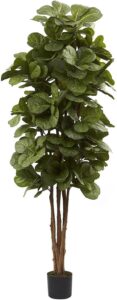 e Nearly Natural 6ft Fiddle Leaf Fig Tree is a notable example, with over 270 intricate leaves and six natural trunks for a complete, realistic look.
e Nearly Natural 6ft Fiddle Leaf Fig Tree is a notable example, with over 270 intricate leaves and six natural trunks for a complete, realistic look. - Silk Plants Direct: Has a big selection of realistic artificial plants.
- Amazon: Has a huge selection, making it easy to compare brands and read reviews.
What to Look for in Quality Products
When buying artificial plants, there are important things to look for. Here are some tips:
- Realistic Appearance: Choose plants with natural-looking colors and textures. Good fake plants look like the real thing. With its hypoallergenic materials and ethically sourced genuine wood trunks, the Cypress & Alabaster 5ft Fiddle Leaf Fig Tree is a unique, artisan-crafted alternative that is perfect for eco-conscious decorators.
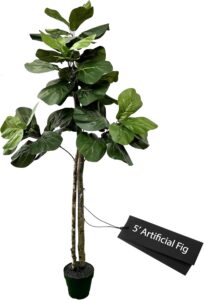
- Durability: If you’ll be using them outside, look for UV-resistant materials. This keeps them looking good through all kinds of weather.
- Weight and Stability: A well-made plant won’t fall over easily. Make sure the base is strong.
- Ease of Maintenance: Pick plants that are easy to care for. Just a little dusting now and then is usually enough.
| Brand | Selection Variety | Price Range | Special Features |
|---|---|---|---|
| Wayfair | Wide | $$ | Customizable options |
| Nearly Natural | Extensive | $$$ | Realistic textures |
| Silk Plants Direct | Diverse | $$ | UV-resistant varieties |
| Amazon | Vast | $-$$$$ | Customer reviews available |
By considering these factors, you can find high-quality artificial plants. They can make your home look beautiful and add a personal touch.
Personalizing Your Space with Artificial Plants
Using fake plants to personalize my home is endless. They bring life and style to my spaces. I can show off my unique taste through different designs and styles.
It’s all about mixing and matching to find my signature look. This way, my home truly reflects who I am.
Creating a Signature Style
Creating a unique vibe in my home is all about choice. I pick the right plants and where to put them carefully. This ensures they match my decor perfectly.
For example, big leafy plants can add energy to modern spaces. Delicate flowers can soften up rustic areas. This flexibility lets me change my space to match my mood.
Incorporating Seasonal Decor
Seasonal decor keeps my home fresh and exciting. In fall, I add warm colors to match my home’s tones. This makes my space feel cozy and inviting.
In winter, I bring in evergreen elements for a festive feel. This keeps my decor lively and makes my home feel personal.
